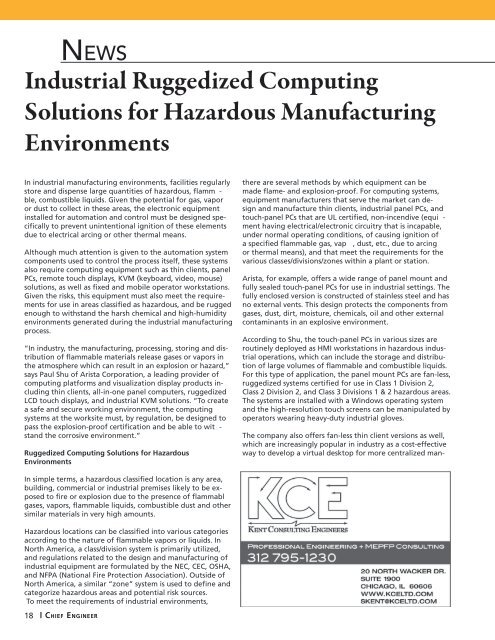CEAC-2022-09-September
You also want an ePaper? Increase the reach of your titles
YUMPU automatically turns print PDFs into web optimized ePapers that Google loves.
News<br />
Industrial Ruggedized Computing<br />
Solutions for Hazardous Manufacturing<br />
Environments<br />
In industrial manufacturing environments, facilities regularly<br />
store and dispense large quantities of hazardous, flamm -<br />
ble, combustible liquids. Given the potential for gas, vapor<br />
or dust to collect in these areas, the electronic equipment<br />
installed for automation and control must be designed specifically<br />
to prevent unintentional ignition of these elements<br />
due to electrical arcing or other thermal means.<br />
Although much attention is given to the automation system<br />
components used to control the process itself, these systems<br />
also require computing equipment such as thin clients, panel<br />
PCs, remote touch displays, KVM (keyboard, video, mouse)<br />
solutions, as well as fixed and mobile operator workstations.<br />
Given the risks, this equipment must also meet the requirements<br />
for use in areas classified as hazardous, and be rugged<br />
enough to withstand the harsh chemical and high-humidity<br />
environments generated during the industrial manufacturing<br />
process.<br />
“In industry, the manufacturing, processing, storing and distribution<br />
of flammable materials release gases or vapors in<br />
the atmosphere which can result in an explosion or hazard,”<br />
says Paul Shu of Arista Corporation, a leading provider of<br />
computing platforms and visualization display products including<br />
thin clients, all-in-one panel computers, ruggedized<br />
LCD touch displays, and industrial KVM solutions. “To create<br />
a safe and secure working environment, the computing<br />
systems at the worksite must, by regulation, be designed to<br />
pass the explosion-proof certification and be able to wit -<br />
stand the corrosive environment.”<br />
Ruggedized Computing Solutions for Hazardous<br />
Environments<br />
there are several methods by which equipment can be<br />
made flame- and explosion-proof. For computing systems,<br />
equipment manufacturers that serve the market can design<br />
and manufacture thin clients, industrial panel PCs, and<br />
touch-panel PCs that are UL certified, non-incendive (equi -<br />
ment having electrical/electronic circuitry that is incapable,<br />
under normal operating conditions, of causing ignition of<br />
a specified flammable gas, vap , dust, etc., due to arcing<br />
or thermal means), and that meet the requirements for the<br />
various classes/divisions/zones within a plant or station.<br />
Arista, for example, offers a wide range of panel mount and<br />
fully sealed touch-panel PCs for use in industrial settings. The<br />
fully enclosed version is constructed of stainless steel and has<br />
no external vents. This design protects the components from<br />
gases, dust, dirt, moisture, chemicals, oil and other external<br />
contaminants in an explosive environment.<br />
According to Shu, the touch-panel PCs in various sizes are<br />
routinely deployed as HMI workstations in hazardous industrial<br />
operations, which can include the storage and distribution<br />
of large volumes of flammable and combustible liquids.<br />
For this type of application, the panel mount PCs are fan-less,<br />
ruggedized systems certified for use in Class 1 Division 2,<br />
Class 2 Division 2, and Class 3 Divisions 1 & 2 hazardous areas.<br />
The systems are installed with a Windows operating system<br />
and the high-resolution touch screens can be manipulated by<br />
operators wearing heavy-duty industrial gloves.<br />
The company also offers fan-less thin client versions as well,<br />
which are increasingly popular in industry as a cost-effective<br />
way to develop a virtual desktop for more centralized man-<br />
In simple terms, a hazardous classified location is any area,<br />
building, commercial or industrial premises likely to be exposed<br />
to fire or explosion due to the presence of flammabl<br />
gases, vapors, flammable liquids, combustible dust and other<br />
similar materials in very high amounts.<br />
Hazardous locations can be classified into various categories<br />
according to the nature of flammable vapors or liquids. In<br />
North America, a class/division system is primarily utilized,<br />
and regulations related to the design and manufacturing of<br />
industrial equipment are formulated by the NEC, CEC, OSHA,<br />
and NFPA (National Fire Protection Association). Outside of<br />
North America, a similar “zone” system is used to define and<br />
categorize hazardous areas and potential risk sources.<br />
To meet the requirements of industrial environments,<br />
18<br />
| Chief Engineer<br />
<strong>09</strong>22 issue.indd 18 8/22/22 3:27 PM
















